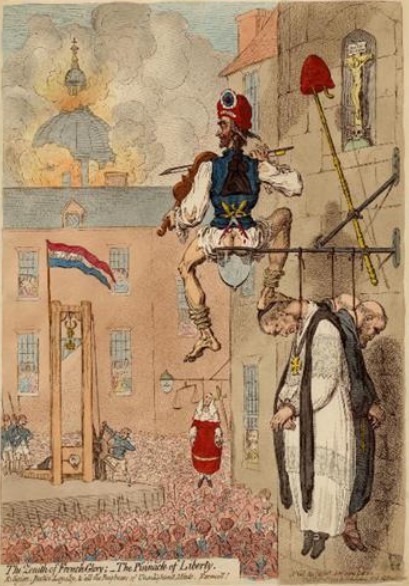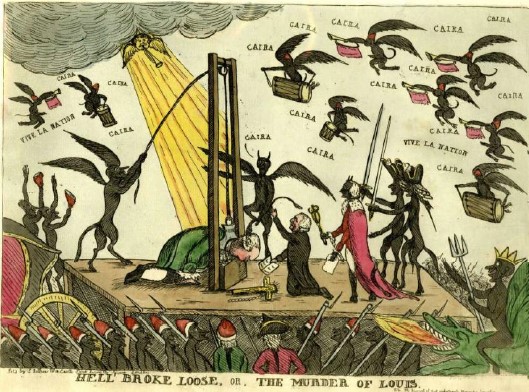En 1ère : Thème 1 Histoire : L’Europe face aux révolutions - Chapitre 1 La Révolution française et l’Empire une nouvelle conception de la nation : un exercice d’entrainement et une évaluation formative.
The French Revolution seen by the British
When the French Revolution started, it aroused great enthusiasm in the English population. However when Terror began, English support faded away and turned into opposition.

Document : a satirical point of view on the French Revolution
The Zenith of French Glory, engraving by James Gillray, 1793, New College, Oxford.)
1) Identify the document (nature, origin, author, historical context)
2) What period of the French Revolution is illustrated in this document ?
3) Describe the document.
4) What figures of authority are destroyed by the French Revolution, according to James Gillray ?
5) Explain why the title and the caption of the flag “vive l’égalité” are ironic.
WORD BOX
The zenith : apogée
A bishop’s crozier : une crosse d’évêque
A scaffold = the guillotine
A church dome
A crucifix
Atheism
A lamp bracket : un support de lampe
A fiddler = a violonist
A cockade : une cocarde
A dagger : un poignard
A pike : une pique
The executioner : le bourreau
Crude/coarse/satirical/ cruel
A sansculotte
To hang : pendre
Bloody/ bloodthirsty / the Terror
Breeches : culotte
Ragged : en lambeaux
Cap of “Libertas” : bonnet phrygien
Correction :
1) This document is a hand-coloured engraving entitled “The zenith of French Glory”. The British caricaturist James Gillray drew this etching in 1793 to commemorate the beheading of Louis XVI (note the crown on the guillotine’s blade). Beneath the title is written “Religion, Justice, Loyalty, & all the Bugbears of Unenlightened Minds, Farewell !”. It was made during the period of the French Revolution. In 1793, the end of the monarchy, the regicide and the reign of Terror caused great dismay among British public opinion. This led the government to launch an anti-revolutionnary campaign. Activated by popular caricaturists (like J. Gillray), it ostracized former supporters of the French Revolution.
3) Description : On the level of the eye, but high above a square in which the guillotine is at work, bodies dangle from lamp-brackets projecting from the wall of a high building on the right. A bishop in his robes and two monks, their hands tied, hang close together from the horizontal bar. On the lantern sits a ragged, bare-legged sansculotte (he is literally sans culottes witout breeches at all) playing a fiddle, looking down with smiling triumph at the crowd ; he is in back view, his bony right foot planted on the head of the dead bishop. On his cap are the words ’Ca ira’, the song of the working class radicals of the French revolution.
. He wears a bag-wig and two daggers dripping blood are thrust through his belt. To the bracket is tied the bishop’s crozier, surmounted by the cap of ’Libertas’. In the wall immediately behind is a crucifix in a niche ; at its foot are a skull and cross-bones. From another projecting lantern in the middle distance hangs a judge in his robes between the scales and sword of Justice, similarly suspended. The high scaffold is surrounded by a sea of bonnets-rouges, waving exultantly as the guillotine falls on Louis XVI. A ragged and grinning sansculotte hauls at the wheel which releases the blade (on which is a crown). From the guillotine flies a tricolour flag inscribed ’Vive l’Égalité. Ragged sansculottes holding spears stand on the scaffold. The windows of the adjoining houses are crowded with spectators. Above their roofs a church dome is on fire.
4) The king + the Church (priests = bishop, monks) + Justice (the Judge)
5) Gillray produced one of the most famous of his anti-revolutionary prints, The Zenith of French Glory ; The Pinnacle of Liberty on 1793, February 12th, which featured the execution of the French King. Following the practice he had begun in 1792, Gillray portrayed the revolutionary sans-culottes not in their preferred working class pantaloons but literally sans culottes without breeches at all. And given the prominence of the clergymen and judge hanging from the lantern posts inThe Zenith of French Glory it is likely that he had heard the revolutionary anthem Ca ira in its more radical form which contained lines like the following :
All will be well, all will be well ! We’ll have no more nobles or priests. The aristocrats will swing from the posts. And equality will reign in the streets.
The sans-culotte fiddler with his bloody daggers in Zenith may be playing the Ca ira, but with the burning church in the background, it’s hard not to associate this image of heartless barbarity with the infamous cruelty of Nero who supposedly fiddled while Rome burned. So according to him, there is not more equality (the sansculotte seems to impose a new order), and no glory (blood, hangings, death, the burning church dome) : it looks like hell. James Gillray suggests that the beheading of Louis, with its disrespect for the monarchy, has resulted in anarchy in France.
GET READY FOR THE EXAM
DOCUMENT : Hell broke loose or the Murder of Louis (Engraving by William Dent, 1793, January 25th).

A) Introduce the document
1) Identify the document (nature, origin, author, historical context). (2 pts)
B) Comment on the document :
2) Describe the document as carefully as possible : (3 pts)
– What do the devils represent ?
– Why is the guillotine given such importance ?
– How is the King represented ?
3) Show that Louis XVI is depicted as a victim, a martyr even, in the document. (2 pts)
4) Explain how the title of the picture emphasises this aspect. (2 pts)
C) Conclude
5) How is the French Revolution seen here ? (1 pt)
Hell broke loose : l’enfer s’est déchaîné
Correction :
A) 1) This document is an hand-coloured etching published by William Dent, only four days after the execution of Louis XVI, on January 21, 1793. It shows the execution of Louis XVI, King of France by guillotine as citizen Louis Capet. Louis XVI (August 23, 1754 - January 21, 1793) was King of France from 1774, when he was not yet 20 years old, until his deposition in 1792. The government was deeply in debt and resentment to ""despotic"" monarchy was on the rise. The success of the American Revolution and the financial crisis occurring in France during his reign were contributing factors to the French Revolution, which abolished the absolute monarchy in France and proclaimed a constitutional monarchy in 1791. Louis XVI enjoyed popularity among the masses, but his indecisiveness and conservatism led some to view him as a symbol of the perceived tyranny of the “Ancien Régime”. Suspended and arrested as part of the insurrection of 1792, he was tried by the National Convention, found guilty of high treason, and executed by guillotine on January 21, 1793 as a desacralized French citizen known as "Citizen Louis Capet", bringing to an end more than a thousand years of French monarchy. Louis XVI is the only King of France ever to be executed.
B) 2) It is a Satire on the execution of Louis XVI ; the king kneeling under the guillotine operated by two winged devils ; Abbé Edgeworth kneeling in front of him, with crucifix and prayer’s book ; angel playing trumpet among clouds surrounded by devils flying above (representing the French revolutionaries) ; army of sans-culottes (all devils) holding bayonets in the foreground. The scaffold placed at the center of the etching highlights the barbary and the violence of the Terror (1793-1794). The only two persons who are not dehumanized (=represented as devils) are the king and the priest : all the others have lost their heart, their reason, and have already joined hell (they have felt into violence, barbary).
3) Louis XVI is kneeling under the guillotine, surrounded by devils (fear, darkness, hell), as a victim. The angel playing trumpet seems to call him to paradise, as a martyr, an innocent and “pure” being surrounded by horrid creatures. He seems to pray (crucifix) and to be blessed by the priest.
4) Hell broke loose : sacred symbols are destroyed, the fire on the foreground, the dragon (hell again = flames of hell)
The “Murder” of Louis : there’s no justice (reinforced by the judge represented as a devil). The use of “Louis” = as a citizen, killed by the devils.
C) 5) Devils stand on the platform as well as fly overhead, suggesting that the beheading of Louis, with its disrespect for the monarchy, has resulted in anarchy in France. The French Revolution, and especially the Terror (1793-1794) is seen as a demoniac, cruel and satanic period which led to the unfair execution of Louis XVI. Obviously, this engraving is an anti-revolutionary piece of art.
Documents joints
Dans la même rubrique
Le tourisme en Australie
Proposition de séance en DNL sur les mobilités humaines transnationales (classe de 4e).
Le sujet d’histoire-géographie de l’OIB 2023
Option Internationale du Baccalauréat session 2023 - Section australienne
Is Sydney a global city ? (débat argumenté)
Proposition de documents pour un débat argumenté en classe de 1ère préparant au BFI.
